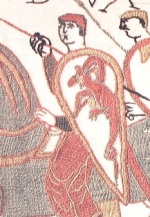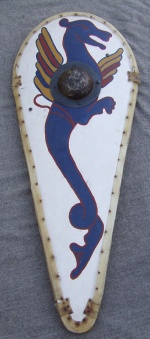Norman shield: Difference between revisions
No edit summary |
No edit summary |
||
| Line 3: | Line 3: | ||
The '''Norman shield''' was used by the [[Norman]]s from the [[11th century|11th]] to [[12th century|12th]] centuries. It is a large, curved [[shield]], often referred to as a '''kite shield''' because of its shape. |
The '''Norman shield''' was used by the [[Norman]]s from the [[11th century|11th]] to [[12th century|12th]] centuries. It is a large, curved [[shield]], often referred to as a '''kite shield''' because of its shape. |
||
A kite shield extends the bottom the the shield down into a long point, giving it an overall "teardrop" shape. This shape means very good protection for the shield-side leg |
A kite shield extends the bottom the the shield down into a long point, giving it an overall "teardrop" shape. This shape means very good protection for the shield-side leg. |
||
In addition, it is cross-strapped, the shield being held in place by an "X" of leather straps. The kite also had two grips, one at the top edge of the shield, allowing it to be wielded with ease [[infantry|on foot]]; and another at a right angle along the edge, allowing a [[cavalry|mounted warrior]] to carry the shield and handle the reins with his left hand, while the right hand wielded a weapon. |
In addition, it is cross-strapped, the shield being held in place by an "X" of leather straps. The kite also had two grips, one at the top edge of the shield, allowing it to be wielded with ease [[infantry|on foot]]; and another at a right angle along the edge, allowing a [[cavalry|mounted warrior]] to carry the shield and handle the reins with his left hand, while the right hand wielded a weapon. |
||
Latest revision as of 15:27, 7 October 2006
The Norman shield was used by the Normans from the 11th to 12th centuries. It is a large, curved shield, often referred to as a kite shield because of its shape.
A kite shield extends the bottom the the shield down into a long point, giving it an overall "teardrop" shape. This shape means very good protection for the shield-side leg.
In addition, it is cross-strapped, the shield being held in place by an "X" of leather straps. The kite also had two grips, one at the top edge of the shield, allowing it to be wielded with ease on foot; and another at a right angle along the edge, allowing a mounted warrior to carry the shield and handle the reins with his left hand, while the right hand wielded a weapon.
It should be noted that the figure in the picture at right has the shield slung at his shoulder, rather than gripped for combat.
It is not known now the extent to which shields of this type and period actually were decorated (although other contemporary sources appear to indicate that they were), nor whether any decoration was a proto-example of personal heraldry, an indication of allegiance amongst different bands fighting together, or the artistic choice of the crafters who made the shields.

